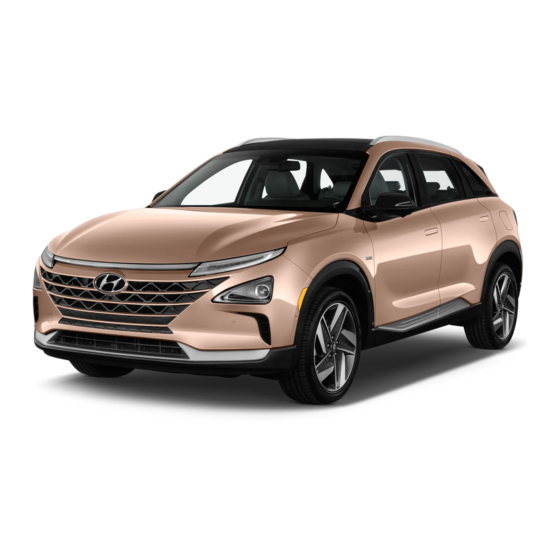Summary of Contents for Hyundai Nexo 2019
- Page 1 Hyundai Nexo & Tucson Hydrogen Fuel Cell Roadside Service Guide Quality and Education Services AAA Automotive June 5, 2019 For the latest updates from AAA, visit: AAAcampus.aaa.biz...
- Page 2 Index Specifications Hydrogen Fuel Cell EV Overview Identifying a Fuel Cell Electric Vehicle Electronic Key/Mechanical Key Start/Stop Switch Electronic Key Not Detected Hood Release Tailgate Release Car Carrier Loading Towing Eyebolt Locations Selecting Neutral Tires and Jacking High-voltage System Fueling Hydrogen Fuel Stations/Pump Ops Jump-Start Procedures Important Notice:...
-
Page 3: Specifications
64.6 inches 65.4 inches Fuel / Propulsion Type Hydrogen / Electric Hydrogen / Electric High-Voltage Battery 240 Volt DC Lithium-ion HV 180 Volt DC Lithium-ion HV Battery Battery *All images found in this document are courtesy of Hyundai Motor America. - Page 4 HYDROGEN FUEL CELL ELECTRIC VEHICLE (FCEV) OVERVIEW In an effort to produce a vehicle that is friendly to the environment, Hyundai developed the Tucson FCEV and has now transferred the technology to the Nexo FCEV. This general overview will assist you with a better understanding of how hydrogen fuel cell technology operates. Fuel Type: Hydrogen Battery: DC Lithium-ion HV How It Works: (Source: www.cafcp.org)
- Page 5 These vehicles have unique badging around the exteri- or of the vehicle to help identify this vehicle from other models on the same platform. Grille Badge - The Hyundai “H” seen in image A has a blue highlight. Image B Fuel Door - Tucson models have a metallic ring with “Fuel Cell”...
-
Page 6: Door Locks
ELECTRONIC/MECHANICAL KEY: Nexo Electronic Key Fob Functions 1 Door Lock 2 Door Unlock 3 Liftgate Unlock 4 Panic Alarm 5 Remote Smart Parking Assist Nexo Tucson 6 Remote Start Tucson Electronic Key Fob Functions 1 Door Lock 2 Door Unlock 3 Tailgate Unlock 4 Panic Alarm Releasing the Mechanical Key Press and hold button 1 and then slide the key out from the fob as seen in the images. - Page 7 Tucson FCEV START/STOP (IGNITION) SWITCH OPERATION: Nexo FCEV The electronic key must be in the vehicle. When detected, a message will display on the driver’s display panel. • Ignition On / Motor Off: Press the Start/Stop switch 2 times without depressing the brake pedal. • To start the motor: Press the Start/Stop switch while depressing the brake pedal.
- Page 8 HOOD RELEASE: Tucson FCEV Nexo FCEV Interior Release: • Pull the release handle located on the driver’s side kick panel. Secondary Release: • Release the secondary release by pulling up on the latch and lift the hood. TAILGATE RELEASE: Electronic Key: •...
-
Page 9: Car Carrier Loading And Transporting
CAR CARRIER LOADING AND TRANSPORTING: Special Precautions: • Car carrier equipment is the recommended method of towing and transporting this vehicle. • When loading or winching, do not use hooks of any type on the lower control arms or any other steering or suspension component. Carefully follow the loading procedures specified on the follow- ing pages. - Page 10 Car Carrier Loading Procedure: Eyebolt Locations These vehicles are equipped with a loading eyebolt found inside the tool kit located under the rear cargo area floor panel that screws into a receiver in the passenger side front and rear bumpers. • Remove the eyebolt receiver cover from the locations shown in the images below. •...
-
Page 11: Parking Brake
Car Carrier Loading Procedures: Before loading, if possible, place the vehicle in Neutral with the parking brake released. Only load the • vehicle onto the car carrier enough to safely transport the vehicle. Stop loading when the winch line begins to pull the vehicle downward. - Page 12 TIRES AND JACKING: Neither vehicle comes equipped with a conven- tional spare tire. Instead, both are equipped with an inflator kit located under the cargo area floor panel. CAUTION: Make sure to secure the vehicle using wheel chocks prior to service. NOTE: Only use the inflator kit as a last resort. Jacking Locations Observe all standard jacking precautions and place the jack in its proper location. Ensure the vehicle is on firm, level ground and that the wheels are chocked. As the jack comes in contact with the vehicle body, ensure that it is not contacting any high-voltage or other components that may be damaged.
-
Page 13: Fuel Cylinders
FUELING: These vehicles do not operate on conventional gasoline or diesel. Instead, they are fueled with compressed hydrogen from an approved fueling station. A special fill port inside the fuel door is used to add hydrogen to the storage cylin- ders. Roadside fuel delivery is not available at this time. In the event an FCEV is found to be out of fuel, the vehicle will need to be towed to the nearest approved hydrogen fueling station and unloaded from the tow vehicle to be... - Page 14 HYDROGEN FUEL STATIONS: Hydrogen fueled vehicles are able to be fueled much the same way as a conventional gasoline or diesel vehicle. However, there are some subtle differences to be aware of. • A pin number is required to operate the pump. This pin number can be obtained once the operator has completed a short instructional video played at the pump demonstrating how to safely fuel the vehicle.
-
Page 15: Jump-Start Procedures
JUMP-START PROCEDURES: NOTE: These vehicles are equipped with two different types of 12v systems. The Tucson has a conventional 12v battery located under the hood while the Nexo is equipped with a lithium-ion polymer type that is integrated into the high-voltage battery. The following jump-starting procedures should be followed for each specific model: • Follow all normal jump-starting precautions as outlined in other AAA/CAA publications. •...
















Need help?
Do you have a question about the Nexo 2019 and is the answer not in the manual?
Questions and answers